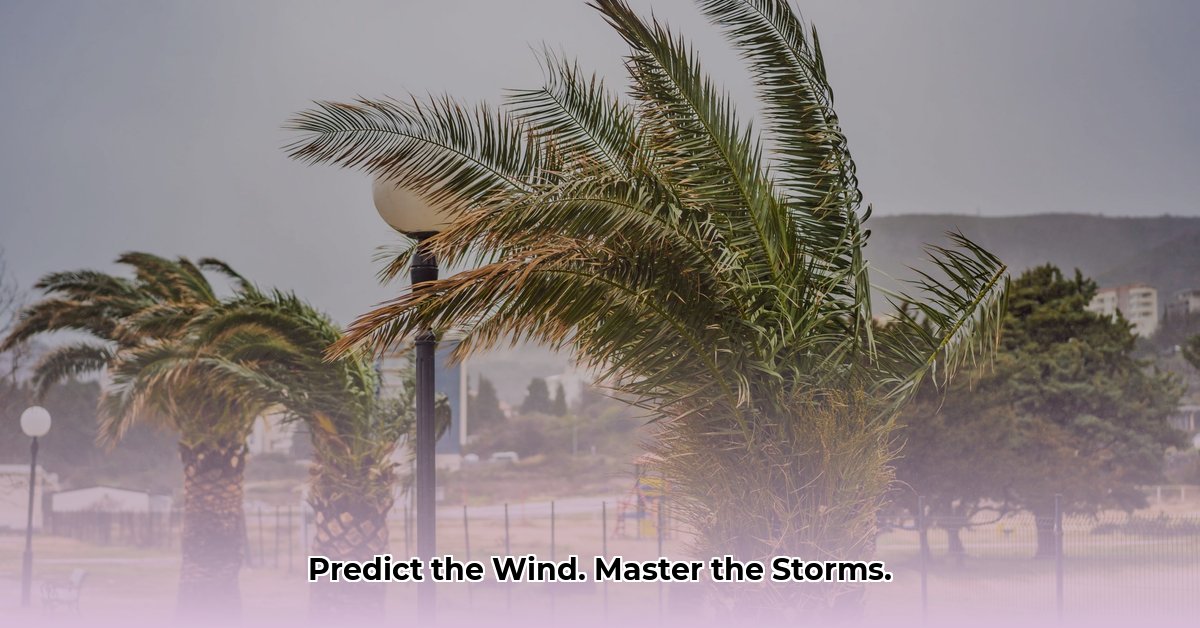Why Wind Prediction Matters
Ever wonder how we know how strong the wind will blow? It’s crucial for everything from safe air travel to maximizing the efficiency of wind farms. While wind can seem unpredictable, advancements in technology and modeling, particularly with AI, are dramatically improving forecasting accuracy. This guide explores the methods, data sources, and applications of wind intensity forecasting, offering a clear understanding of this vital field.
Decoding the Wind: Forecasting Methods
Predicting wind strength involves understanding the complex dynamics of the atmosphere. Sophisticated computer models, driven by physics and mathematical equations, simulate atmospheric movement. These models are constantly refined, incorporating vast amounts of data to generate increasingly accurate forecasts.
The Data Behind the Predictions
These models rely on a variety of data sources:
- Weather Stations: Ground-based stations record temperature, pressure, humidity, and wind speed.
- Satellites: Orbiting satellites provide a bird’s-eye view of weather patterns and atmospheric conditions.
- Radar: Radar systems track wind movements and detect precipitation.
- Aircraft: Airplanes collect valuable atmospheric data during flight.
Each data point contributes to a comprehensive understanding of the atmosphere.
Forecasting Tools: Models and Software
Key tools in wind intensity forecasting include:
- Weather Research and Forecasting (WRF) Model: A versatile model simulating atmospheric conditions at various scales.
- Global Forecast System (GFS) Model: Provides global weather predictions, crucial for long-range forecasting.
- Specialized Software (e.g., Windfinder): Translates complex model data into user-friendly forecasts.
| Forecasting Model | Description | Strengths | Weaknesses |
|---|---|---|---|
| WRF | Adaptable model for research and forecasting | High resolution, customizable for specific regions | Computationally intensive |
| GFS | Global weather prediction model | Broad coverage, essential for long-range forecasts | Lower resolution than regional models like WRF |
The Impact of Wind Forecasts
Wind intensity forecasting has wide-ranging applications:
- Renewable Energy: Optimizes wind farm operations, maximizing energy capture and grid stability.
- Aviation: Ensures safe flight planning by predicting turbulence and wind conditions.
- Recreation: Informs decisions for activities like sailing and kiteboarding.
Shaping the Future of Wind Prediction
The future of wind forecasting is bright, with AI and machine learning promising increased accuracy and longer forecasting horizons. This could revolutionize wind energy, weather warnings, and our understanding of the climate system.
Precision Wind Intensity Forecasting: A Deep Dive
Predicting wind intensity accurately is fundamental to the effective use of wind energy. It enables efficient grid management, optimizes wind farm operations, and informs long-term energy planning. Two primary approaches are used:
- Physical Models: Based on physics and terrain data, these models calculate wind behavior, especially useful for short-term forecasts.
- Statistical Models: Data-driven models that learn from historical weather data. Advanced algorithms like neural networks, time series analysis, and Kalman filtering uncover hidden relationships, similar to predicting stock market trends.
Ensemble methods, combining predictions from multiple models, often using a technique called stacking, improve overall forecast accuracy.
Factors influencing prediction accuracy include:
- Data Quality: Accurate data is essential for reliable predictions.
- Model Complexity: The appropriate model complexity depends on the specific forecasting needs.
- Forecast Timeframe: Longer-term predictions are inherently more challenging due to accumulating uncertainties.
Advanced Algorithms for Precision Forecasting
Several specialized algorithms are used in precision wind intensity forecasting:
- Long Short-Term Memory (LSTM) Networks: Neural networks adept at remembering patterns over time, ideal for wind speed forecasting.
- Bidirectional LSTM (BiLSTM) Networks: Analyze data both forward and backward in time, potentially improving accuracy.
- Gated Recurrent Unit (GRU) Networks: Similar to LSTMs but often computationally more efficient.
- LSTM-Attention: Focuses on the most relevant parts of the input data, improving prediction efficiency.
- Stacking Algorithms: Combine predictions from multiple base learners (e.g., LSTMs, GRUs) to achieve a more robust and accurate forecast.
- Principal Component Analysis (PCA): Simplifies data and reduces noise, enhancing model learning.
Cutting-edge techniques like transfer learning, applying knowledge from related domains, are further enhancing prediction accuracy. As models and data improve, we can expect even more precise wind forecasts, crucial for maximizing the potential of wind energy.
Data Sources: Fueling Accurate Forecasts
Accurate wind forecasts rely on a blend of diverse data sources:
- ERA5: Reanalysis data from the European Centre for Medium-Range Weather Forecasts (ECMWF).
- MERRA-2: Reanalysis data from NASA.
- Wind Atlases: Region-specific wind data resources.
- Global Forecast System (GFS): Widely used global weather prediction model.
These data sources are combined to create a comprehensive view of wind conditions. The accuracy of forecasts is evaluated by comparing predictions with actual wind data from sources like operational wind farms, such as WindFloat Atlantic. Statistical metrics like Mean Absolute Error (MAE), Mean Squared Error (MSE), Standard Deviation (SD), and Relative Error quantify the accuracy of predictions.
Several factors influence forecast accuracy:
- Data Quality: Reliable input data is crucial.
- Model Resolution: Higher-resolution models capture finer details.
- Local Terrain and Weather: Terrain and weather patterns influence wind behavior.
- Forecast Horizon: Longer-term forecasts are more difficult.
Ongoing research focuses on improving wind predictions by combining multiple data sources and using machine learning algorithms.
Applications: Harnessing the Power of Wind
Wind intensity forecasting has a significant impact across multiple sectors:
- Grid Management: Balancing supply and demand by anticipating fluctuations in wind power. This helps prevent blackouts and reduce reliance on fossil fuels.
- Turbine Maintenance: Scheduling maintenance during periods of low wind speed to minimize downtime and maximize energy production.
- Energy Trading: Informing trading decisions by predicting wind power generation.
- Wind Farm Placement: Assessing long-term wind resources to determine optimal locations for new wind farms.
- Curtailment Strategies: Managing excess wind power to protect the grid.
- Renewable Energy Integration: Combining wind forecasts with predictions for other renewables to optimize a mixed energy portfolio.
Forecasting Methods: A Closer Look
Wind forecasting employs various methods, each with its own strengths and weaknesses:
- Physical Models: Simulate atmospheric conditions using physics and meteorological data.
- Statistical Models: Analyze historical wind patterns to identify trends and make predictions.
- Machine Learning (ML): Uses algorithms trained on vast datasets to identify complex relationships and improve prediction accuracy.
- Hybrid Models: Combine the strengths of different approaches.
| Method | Description | Strengths | Weaknesses |
|---|---|---|---|
| Physical Models | Simulate atmospheric conditions using physics and meteorological data. | Provides a deep understanding of the physical processes. | Computationally intensive, requires extensive data. |
| Statistical Models | Analyze historical wind patterns to identify trends. | Relatively simple and efficient. | May not capture complex relationships, less accurate during extreme events. |
| Machine Learning | Utilize algorithms trained on vast datasets. | Can uncover subtle patterns, leading to higher accuracy. | Requires large, high-quality datasets for training. Can be a “black box.” |
| Hybrid Models | Combine different modeling techniques. | Leverages the strengths of different approaches. | Can be complex to develop and maintain. |
The field of wind forecasting is continuously evolving, with ongoing research and development leading to more accurate and reliable predictions. These advancements are crucial for harnessing the full potential of wind energy and building a sustainable energy future.
- Hydropower Drink Fuels Motocross Riders, Combats Arm Pump - December 18, 2025
- Hydropower Technology Innovations Drive Future Of Renewable Energy - December 17, 2025
- Water Mill Electricity Generator Provides Free Home Power - December 16, 2025
















